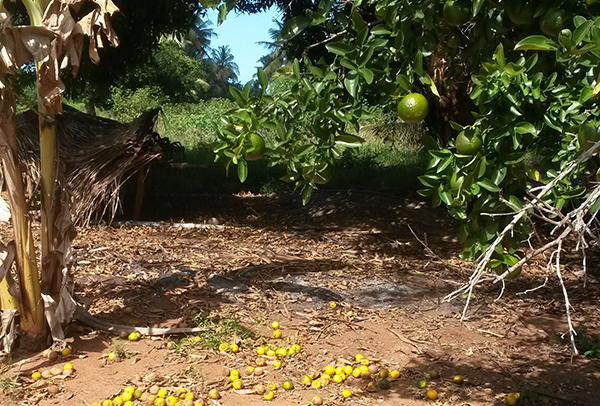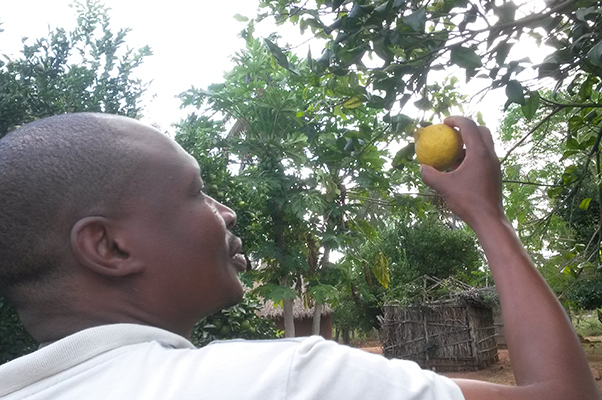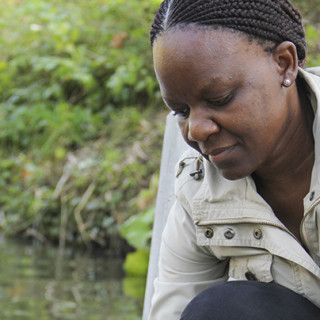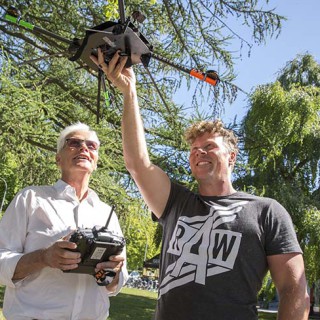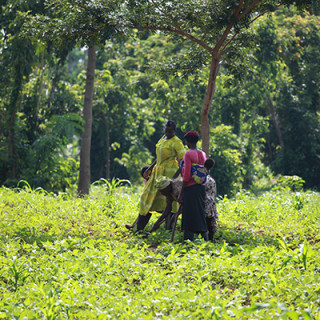Juicy fruit drying in the sunshine
Imagine living in a country with an abundance of fruit, but not being able to preserve them for consumption throughout the year. That is currently the case in many African countries, such as Mozambique. Until now there has been a lack of simple preservation methods, and a lot of fruit has thus been spoiled. Randi Phinney and her colleagues at Lund University and in Maputo, Mozambique, have now introduced bags made of a breathable textile as a new way of drying fruits.
Mozambique is a developing country that struggles with malnutrition despite its abundant natural resources and great supply of crops. Harvested fruits and vegetables that are not consumed immediately spoil and never reach the end consumers. One reason for this is that most food preservation technologies are only profitable for large-scale production and require major energy inputs and good transport infrastructure. Another reason is that large quantities of both cultivated and wild fruits go unharvested due to short seasons.
When Professor Emeritus Petr Dejmek at the Department of Food Technology, Engineering and Nutrition, was in Mozambique on a field trip with students from Eduardo Mondlane University in Maputo, he realised how much citrus fruit was going to waste in one season. From this insight he eventually got the idea for a new fruit preservation technology for sunny climates – to use bags made of breathable textiles, permeable to water vapor but not to liquid water, that could allow even juicy fruits to dry sufficiently for them to be preserved.
The new technology for preserving fruit is termed “Solar Assisted Pervaporation” (SAP). In short, the SAP technique works like this: With the help of the energy from sunlight water vapour evaporates through the bags filled with fruit in the form of juice or mash which consequently become more and more concentrated.
“Using breathable bags and solar energy, we may create concentrates such as syrups.”
This is the first time that this kind of breathable textile – designed in cooperation with the ”Smart Textiles” project at Borås University – is used for concentrating food products, and Randi Phinney, PhD student at LTH, is working on the development and scientific understanding of the SAP technique.
“As a first step we have now shown that by using breathable bags and solar energy, it is possible to create concentrates such as pastes, syrups and fruit leathers that can either be eaten as such or re-hydrated back into juice”, said Randi Phinney.
During the coming years she and her colleagues will work on optimising the design, the process and the properties of the textile and on really understanding the science behind the technique. According to Marilyn Rayner, principal supervisor of Randi Phinney, it is also important that they gain the whole perspective – including social aspects – and understand what the needs are, before finalising the product.
That is why Randi Phinney will soon be returning to the rural areas in the province of Inhambane, Mozambique. This time some of the farmers and families will try the method on local fruits, but she will also continue her investigation of the market.
“Our basic idea is that that the bags need to be hygienic and easy to handle, and you must be able to wash and reuse them”, said Randi Phinney. “However, we also need more knowledge of what people want – what is an attractive design, which size works best, how we can design the process to best fit the user’s lifestyle, etcetera”.
Text: Pia Romare
Photo: Randi Phinney
Facts
-
Pervaporation
-
Pervaporation: a processing method for the separation of mixtures of liquids by partial vaporisation through a non-porous or porous membrane.
-
Drying juicy fruit
-
Drying juicy fruit
Place the fruit inside the bag – the fruit may be in the form of juice/purée, sliced or mashed. Seal the bag and let it dry by either hanging it up or laying it down on a rack in the sun or in a solar dryer. The drying time is usually a couple of days depending on the temperature, the relative humidity, the air convection, and the thickness of the fruit or liquid layer inside the bag. From fruit juices/purées it is possible to produce juice concentrates, jams, syrups and candy (fruit leather).
This is how it works: If you fill the bag with fruit juice or mash, the liquid will remain in the bag, but with time the water will evaporate and the fruit becomes more concentrated. The process is driven by differences in the partial pressures of water vapour. As long as the humidity outside the bag is relatively lower than the humidity (i.e. water activity) inside the bag, water will evaporate. This is enabled by the breathable textiles, which consist of one outer layer to withstand abrasion and one ‘active’ inner second layer (membrane) which is permeable to water vapour (a process similar to pervaporation).
Increasing temperature and decreasing relative humidity generally increases evaporation. By using a solar dryer, it is possible to increase the air temperature to become higher than the ambient surroundings (thereby decreasing the relative humidity) to accelerate the dehydration of a product. For example, by using an indirect solar dryer, in which air enters a tunnel with a black bottom and glass top, heats up and exits through a chimney in an attached wooden box, natural convection is increased.
-
Advantages of the SAP technique
-
Advantages of the SAP technique
The technique is aimed at small-scale farmers and families to use shortly after harvesting. The bags are easy to handle and can be cut in a way to avoid spillage. The technique is hygienic. First, the fruit is protected from rats, birds and dust. Second, bacteria and viruses cannot get through the membrane layer of the bags. Many juicy fruits are also very acidic so the growth rate of intrinsic spoilage microorganisms is greatly reduced. This means the fruit does not spoil inside the bags while being concentrated. When the fruit is sufficiently concentrated it becomes shelf-stable and it may be stored for a long time without the need for refrigeration.


